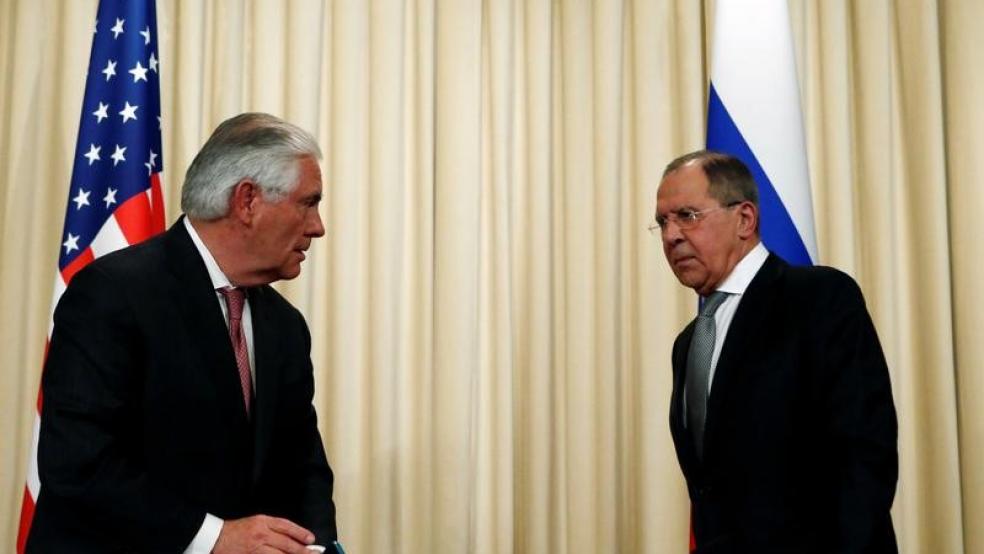Now that Russia and China have jumped to the top of Donald Trump’s foreign policy agenda, how’s the president doing with Washington’s two most important relationships outside the Atlantic alliance?
The crises in Syria and North Korea have suddenly complicated U.S. ties with Russia and China respectively, and Team Trump doesn’t seem to have the diplomatic savvy the moment calls for.
Related: Tillerson Hits Russia with Ultimatum: Syria’s Assad Must Go
It’s early days, but so far they’re getting Moscow and Beijing wrong. The risks are failures or dangerous military escalations in Syria and the Korean Peninsula along with further deterioration in relationships that the Obama administration had already made needlessly antagonistic.
Secretary of State Tillerson hit a stone wall when he traveled to Moscow Tuesday for talks with President Putin and Foreign Minister Sergei Lavrov. When Trump summited with Xi Jinping a week ago he opened the door on North Korea but didn’t cross the threshold. The Chinese president has since pitched in on North Korea, but so far, this amounts to symbolic gestures intended to mollify a world leader who seems less predictable by the day.
There’s a common problem here. After months of relentless pressure for his unorthodox foreign policy ideas, Trump gradually surrendered policy to the Pentagon. Defense Secretary Mattis and National Security adviser H.R. McMaster—the former retired general still in uniform—effectively run the policy process now.
With Stephen Bannon’s recent removal from the National Security Council—at McMaster’s insistence—there’s no one left in the president’s inner circle to balance the Pentagon’s advice, my sources in Washington say. This is a big mistake. Generals are trained to execute policy, diplomats to shape it.
Related: China Says Trump Initiated Phone Call With Xi
A markedly more assertive tone in Washington is already obvious. In a single week, the administration has given Moscow and Beijing ultimatums on Syria and North Korea, along with threats to “go it alone” if they don’t fall in line with U.S. strategy.
Here’s the problem: Russia and China, both nuclear-armed and both harboring great-power aspirations, are essential to the resolution of these crises. And neither shows any sign of responding positively to the White House’s newly forthright posture.
Russia. Trump and Tillerson have pushed the U.S.–Russia relationship full-tilt toward open hostility since the chemical weapons attack in Syria last week and the Pentagon’s retaliatory strike at a Syrian airfield. Trump, Tillerson, Putin, and Lavrov all say the same thing now: Bilateral ties could hardly be worse.
Tillerson’s big mistake in Moscow this week was putting a with-us-or-with-Assad ultimatum on the table. Compounding the error, administration officials simultaneously said Moscow had advanced knowledge of the gas attack, was possibly complicit and was covering it up.
Related: U.S.-Russia Relations at Another Low After Syria Attacks
There’s no mileage in any of this. Tillerson’s ultimatum betrays a serious failure to understand Russia’s interests in Syria—the first thing a seasoned diplomat would calculate. Even Mattis had to step back from the string of ungrounded charges undercutting Tillerson’s already tough tasks in Moscow.
Whatever chance Trump’s “détente” ever had, it’s off now. Tillerson acknowledged that “the world's two foremost nuclear powers cannot have this relationship,” but what’s next? On Thursday, Trump suggested there are still ways to salvage relations, but this was plain vanilla: He didn’t name any.
China. Trump’s focus shifted to North Korea’s nuclear crisis as soon as Xi’s flight left Mar–a–Lago for Beijing last weekend. By Tuesday he had implicitly given China an ultimatum similar to Tillerson’s in Moscow.
“North Korea is looking for trouble,” the president Tweeted. “If China decides to help, that would be great. If not, we will solve the problem without them! U.S.A.” By the time that went out, the Pentagon had already ordered the U.S.S. Carl Vinson, a carrier strike group, to waters off the Korean Peninsula.
Related: U.S. Says Russia Should Abandon Support of Syria's Assad
Trump wants what several of his predecessors never got: U.S. policy rests on getting China to bring Pyongyang into line, with the threat of military intervention in the background. Trump’s problem in the making is that he’s not going to get any further than Obama, Clinton, or either of the Bushes.
In a Wednesday telephone exchange with Xi, Trump seemed to make progress. He offered to drop plans to declare China a currency manipulator and negotiate a lenient new trade deal if China would tighten the screws on the North. Beijing then warned Pyongyang publicly to stop its missile-testing program “for its own security.”
But there’s less here than meets the eye, as a reading of that People’s Daily warning makes plain. Washington, the paper explained, “is brimming with confidence and arrogance following the missile attacks on Syria.”
That’s not the remark of a government coming over to Donald Trump’s side. On Thursday Foreign Minister Wang Yi made Beijing’s view perfectly plain. “Military force cannot resolve the issue,” Wang told reporters. “Amid challenge there is opportunity. Amid tensions, we will also find a kind of opportunity to return to talks.”
Talks between Washington and Pyongyang have long been the only way to resolve the North’s nuclear activities, in China’s view. No number of wielded sticks or proffered carrots are likely to budge China from this position.
Tensions in its neighborhood make the Chinese nervous. But the Pentagon’s longstanding military presence in the region and any suggestion that Washington controls security in the Western Pacific makes it even more nervous. Until Team Trump grasps this, it’s not going to get any further with the Chinese than Rex Tillerson did with the Russians this week.






